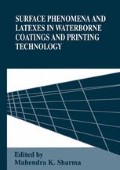Abstract
Extremely high shear rates are applied to pigment dispersions during various scale-up and manufactring processes in several industries. As reported in this paper, one has to know the rheological properties of dispersions under high shear, which can not be estimated but have to be measured under similar conditions. Carbonate and clay slurries exhibit a maximum in viscosity with increasing shear rate, responsible for failures in coating processes. Several additives under investigation shift the maximum towards higher shear rates and reduce its height. Water-soluble polymers might even level it off, depending on their molecular weight and molecular weight distribution. It is concluded that the polymers stabilize the liquid layer around the particles. Hence, shear forces may disaggregate floes, but will not increase the interparticle repulsion.
Access this chapter
Tax calculation will be finalised at checkout
Purchases are for personal use only
Preview
Unable to display preview. Download preview PDF.
References
Ribitsch, V., Proceedings of the 35th Rheology Symposium of the Japanese Rheological Society, 57–61, (1987).
Laun, H.M., Hirsch, G.L., Rheol. Acta 28, 267–272, (1987).
Eklund, D., Strand, M.,Wochenblatt für Papierfabrikation 15, 577, (1980).
Ribitsch, V., Ch. Jorde, J. Schurz, GIT 26(12), 1112–1116, (1982).
Mooney, M., Trans. Soc. Rheol., 2, 210–216, (1931);
J Colloid Sci., 6, 162 (1951).
Pfragner, J., Progr. in Colloid & Polymer Sci., 77, 177–183, (1988).
Schurz, J., Wochenblatt für Papierfabrikation, 8, 275–279, (1984).
Jastrzebinski, J., EC Fundamentals, 6(3), 445–454, (1967).
Author information
Authors and Affiliations
Editor information
Editors and Affiliations
Rights and permissions
Copyright information
© 1995 Springer Science+Business Media New York
About this chapter
Cite this chapter
Ribitsch, V., Pfragner, J. (1995). The High Shear Rheological Properties of Dispersions. In: Sharma, M.K. (eds) Surface Phenomena and Latexes in Waterborne Coatings and Printing Technology. Springer, Boston, MA. https://doi.org/10.1007/978-1-4757-2395-3_14
Download citation
DOI: https://doi.org/10.1007/978-1-4757-2395-3_14
Publisher Name: Springer, Boston, MA
Print ISBN: 978-1-4419-3247-1
Online ISBN: 978-1-4757-2395-3
eBook Packages: Springer Book Archive

